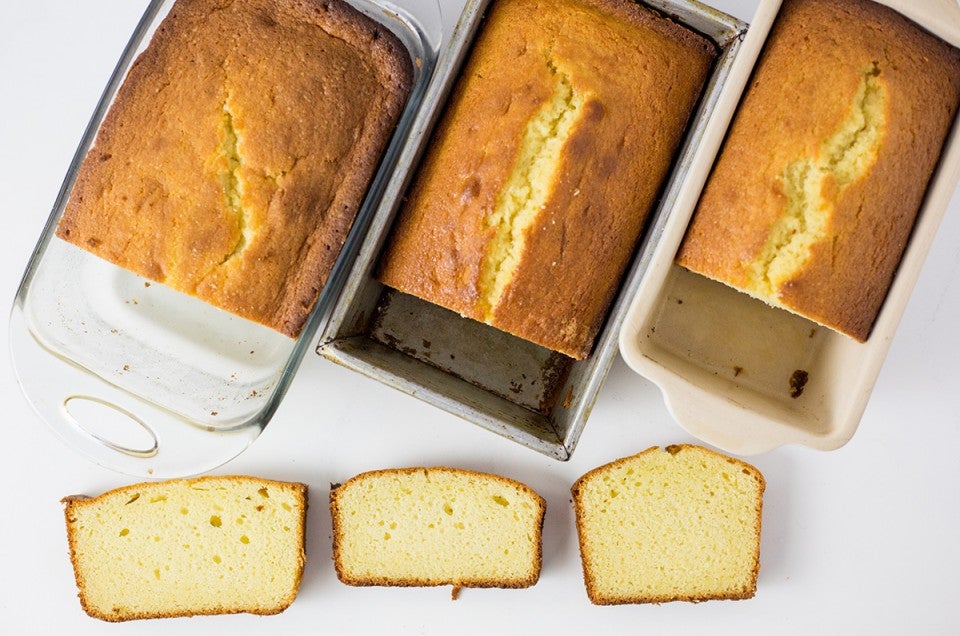


When it's time to bake, you reach for the pan you have, often without thinking about what it's made of. If your recipe calls for a 9" x 5" loaf pan, you grab the one in your cupboard and fill 'er up. What might surprise you is that your results can be dramatically different, depending on whether you've baked your recipe in a glass or metal pan. Stoneware, another common material in bakers' kitchens, has its own set of behaviors.
Let's explore how the pan you're baking in can change your results.
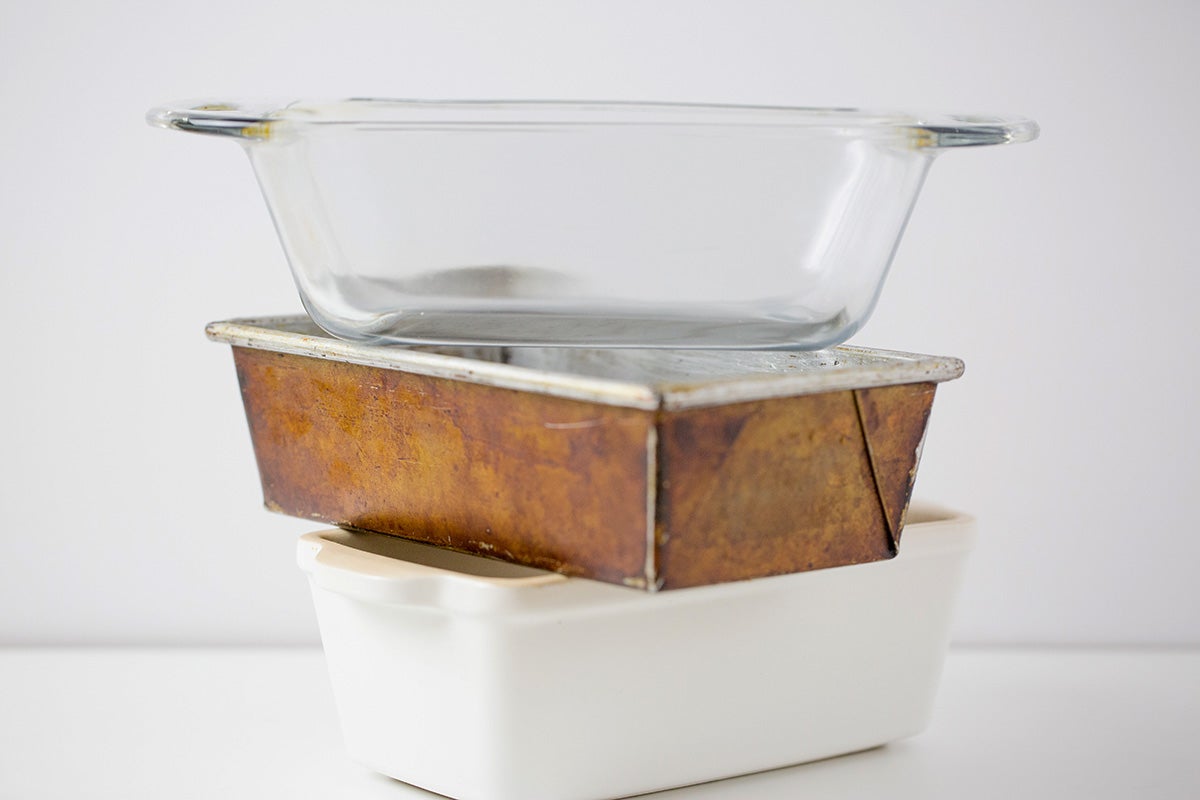
When you put something in the oven to bake, the ideal scenario is for a smooth, even transfer of the oven's heat from the air around your pan through its sides and in turn, through the batter or dough within. As the ingredients warm up, the magic happens. Leaveners are activated, things rise and are eventually set in their finished form, all while the kitchen smells heavenly.
The ideal vessel for baking in most cases is a light-colored pan made from a metal that's an efficient heat conductor. (Read more about pan colors and their effect on baking.)
Aluminum is the material that most professionals reach for.

Glass pans are extremely common – and they have advantages of their own – but be aware that they are insulators. Glass slows the flow of heat between the oven's air and your batter, until the glass itself heats up. Then the glass retains heat far longer than metal will.
Because of these properties, batter baked in glass often takes longer. At the same time, it's easier to over-bake brownies in a glass pan, because it takes longer for the center to cook. By the time the center finishes, the glass is acting like a heat sink, and the outer edges of your brownies are getting very tall and probably pretty hard.
What's good about glass? It's non-reactive, which means it won't corrode from the acid in your lemon cake, or change the flavor of anything you bake in it. You can see through it, which is great for pie crusts; just peek underneath! And once glass heats up, it will do a good job of making sure bottom crusts get crisp and golden.
After doing some research, I learned why I've had such inconsistent results with stoneware. With this kind of pan, it's all about the composition of the clay, and in some cases, how it's made.
Hand-thrown pie plates will bake differently than a stoneware pan made from liquid slip poured into a mold. A hand-thrown plate is likely to have more air pockets in it, which will slow down heat transfer. The amount of minerals and metals in the clay itself also determines the rate at which heat can move through the pan.
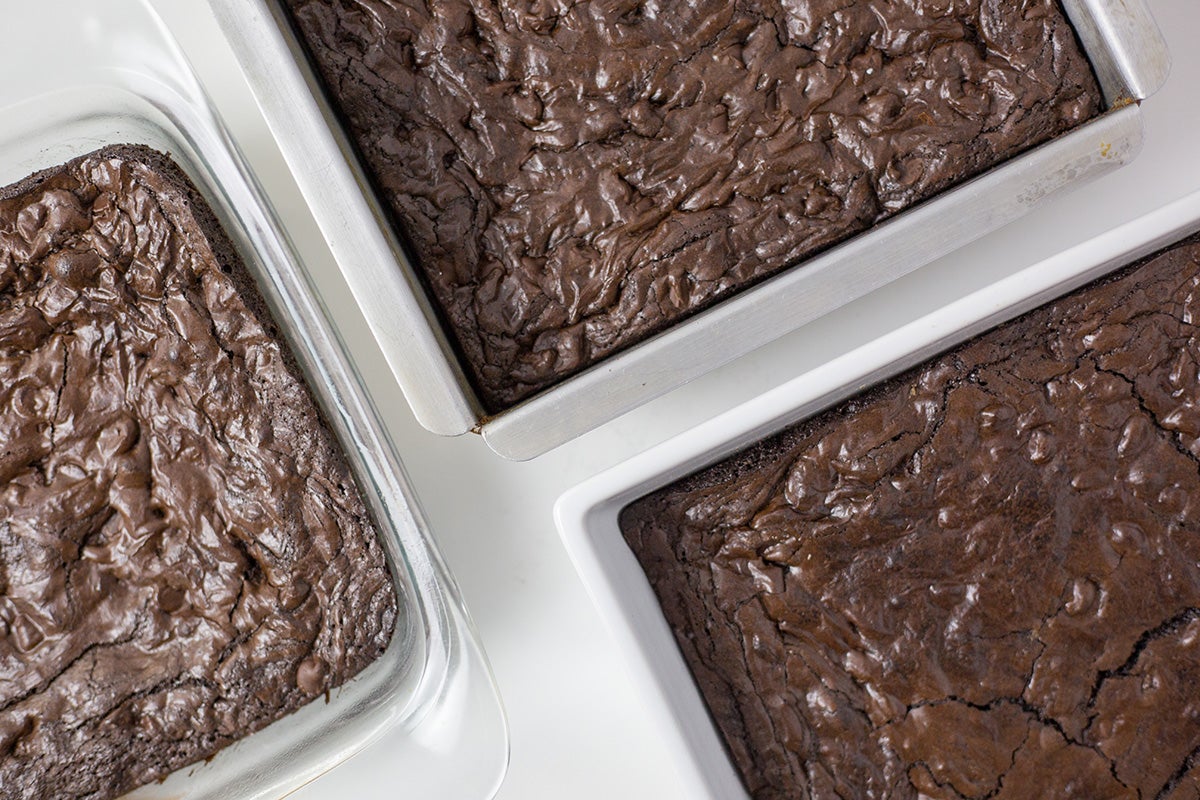
We make several batches of our Fudge Brownie recipe, and bake them side by side in the same oven for the same amount of time.
See the edge of the glass pan batch climbing up and curling inward? The glass heats up more slowly than metal, melting the sugar in the batter. Once the glass is hot, it holds on to the heat instead of transmitting it inward. The hotter edge causes the batter to climb higher and cook further than the batter in the other pans.
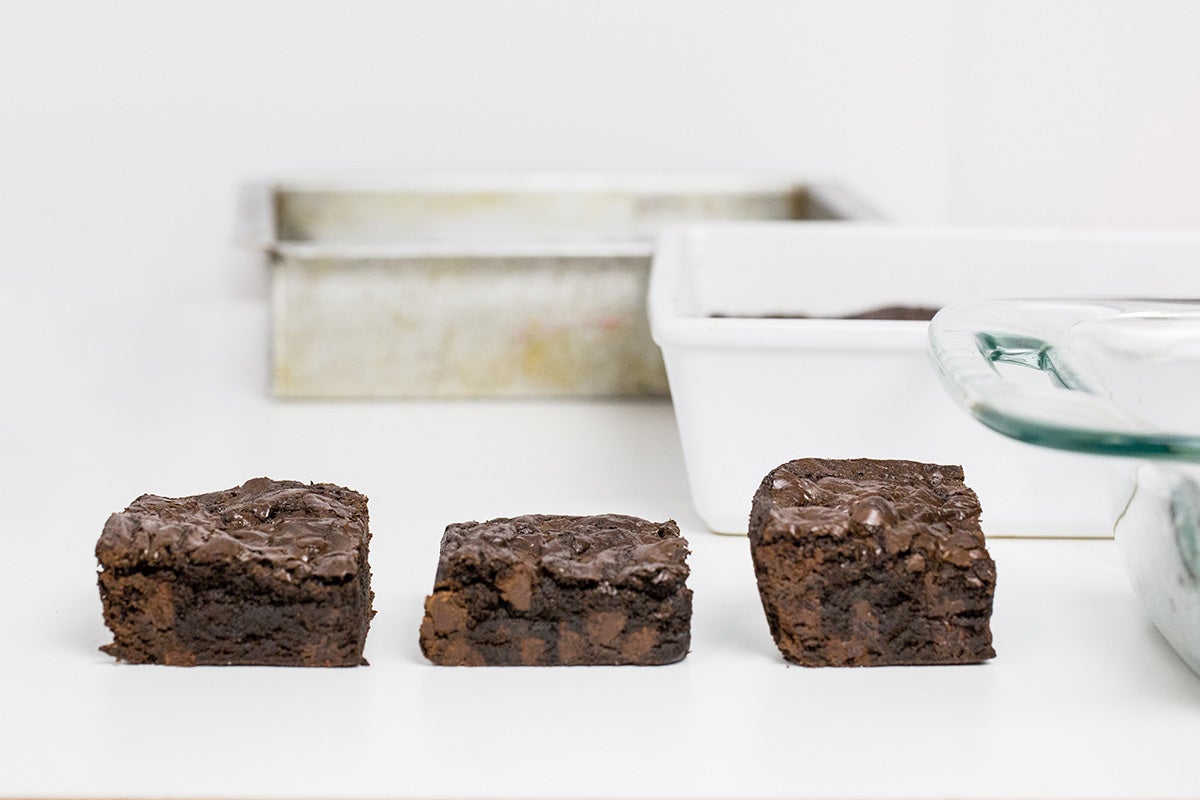
As you can see, the different shapes and dimensions of the pans give some distinct differences when you line them up.
All three brownies have nice, shiny tops. The metal pan is a true 8" square. The stoneware pans' sides are slightly sloped, and the dimensions are more like 8 1/2" square, so the batter is spread a little thinner.
The glass pan shows the most dramatic difference between the top and bottom dimensions, but the curve you see at the back of the brownie is on display, as well as the downhill slope toward the brownie's inner corner. The outside edge of this brownie is much crunchier and harder than brownies from the stoneware or metal pans.
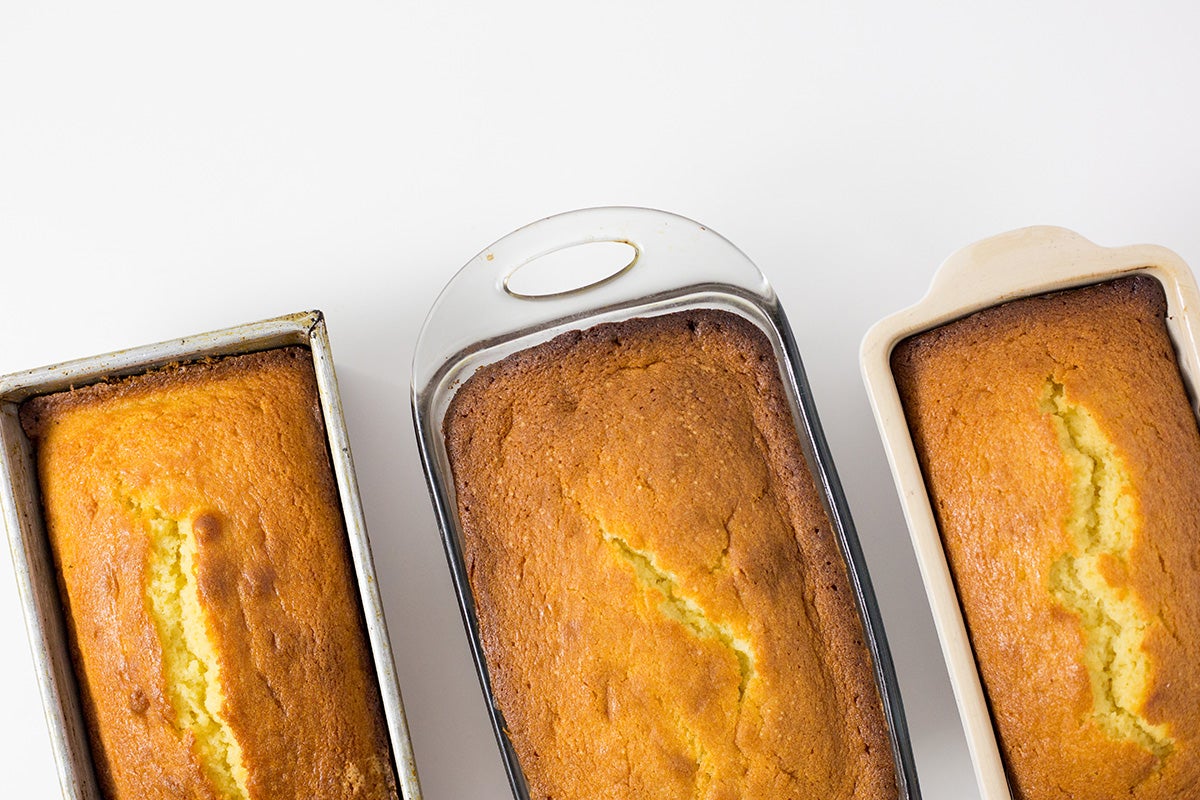
Pound cake is a high-sugar, high-fat formula that takes more than an hour to cook all the way through. As this lineup of cakes shows, reaching for glass or metal or stoneware will change the way the cake bakes. The shapes of these pans are different, with glass having the widest span across the top.
It's interesting to note that the dome of the glass-baked cake is the lowest; that's a function of slower heat transfer. The outside edge also shows the rounded, souffléd edge we saw on the brownies. The taller tops of the metal and stoneware cakes are a result of the heat traveling faster from edge to the center, activating the leavener before the center set and sending the middle upward.

The cross-section of these cakes are a surprise at first. I expected the glass slice to have the darkest, thickest crust, but the reverse is true.
On further reflection, I realize the insulating properties of the glass protect the bottom edge to a degree. The metal and stoneware pans have darker edges; as the heat moves through the batter, it helps the tops get higher, but the sugar and fat in the formula cook more efficiently (and get darker) where they're in contact with the pans.
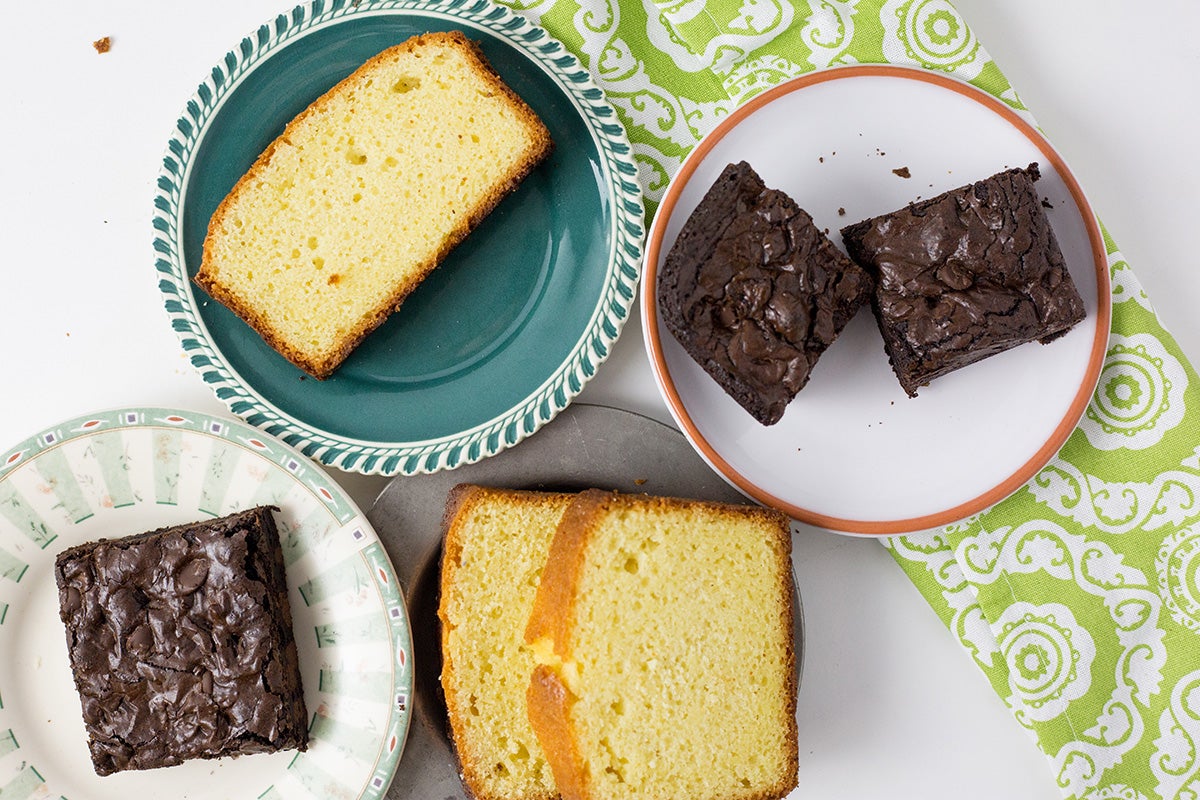
King Arthur Flour recipes are tested in metal pans, for their baking efficiency and accuracy for size. Glass pans' dimensions can be all over the place (try taking a measuring tape to the store next time you shop; you might be surprised). Stoneware composition varies too much to rely on for testing (different levels of conductivity and sizes are often not exact).
That said, any pan is the right pan if it helps you put baked goods in the oven. The standard advice for baking in glass is to lower the oven temperature by 25°F from what the recipe calls for, and bake up to 10 minutes longer. The hard edges we see here are more pronounced in high-sugar, high-fat recipes; your casserole or bread pudding are less likely to be adversely affected.
Stoneware just takes some getting to know; once you learn how your pan bakes, you can make any adjustments that work for you. And you can always reach out to the Baker's Hotline, if you're not sure where to start.
Let us know what your favorite baking pan is made of, and what you're baking in it, in the comments below.


November 22, 2023 at 1:05pm
Good morning and Happy Thanksgiving to all of you,
Another question--after calculating the total volume of a bread baking vessel in ml, what is the ideal percentage of bread dough to fill the pan prior to the final rise and the bake?
November 25, 2023 at 2:32pm
In reply to Good morning and Happy… by David M (not verified)
Hi David, we don't have an exact percentage of bread dough per pan, and this will likely vary a bit, depending on how high rising a particular bread recipe happens to be. However, you may find this blog post helpful in determining the correct size bread pan to use with various amounts of dough.
October 24, 2023 at 4:12pm
I have a convection oven and a glass round dish that I would like to use for baking bread. I have not been baking for awhile now and want to get back into it but forgot how long to bake my bread at. I do bake at 375° instead of 400°. Any suggestions would be appreciated.
Thank you
Darlene
October 27, 2023 at 2:11pm
In reply to I have a convection oven and… by Darlene (not verified)
Hi Darlene, the bake time will depend on the type of bread and the loaf size that you are making. Feel free to give our bakers a call at (855) 371-2253 (BAKE).
September 28, 2023 at 5:36pm
Glass or metal or stoneware | King Arthur Baking
https://www.kingarthurbaking.com/blog/2018/03/29/glass-or-metal-or-ston…
Sent from Mail for Windows
Good afternoon,
I happened upon a white ten inch by three inch ceramic bread pan at a local thrift store. It was in excellent condition. When I flipped it over to examine the underside, it had “King Arthur Flour” printed in black on the bottom. I smiled and thought, “Fate.” I am buying this.
I really like the size loaf it produces. Because the loaf pan is made of stoneware/ceramic, I have reduced the heat by twenty degrees each time I use it. I always line my baking pans of any material with parchment paper. I really like the size of the loaf the pan produces.
Here’s the issue. I bake a whole wheat bread recipe in the King Arthur baking pan. The loaf always splits along the length of one side. I am careful to ensure the recipe has enough moisture as wheat flour absorbs a lot of liquid. Also, I knead the dough by hand. I don’t ever expect a 100% window pane test since it’s wheat bread and since the dough needs to have some reserved elasticity for the final rise while baking. I knead this dough slowly, quickly, give it a chance to rest for ten to fifteen minutes, knead it again for a good twenty minutes, and allow it to rest and rise for forty-five minutes. The final rise after shaping is a recommended half hour. Sometimes, I notice the dough begins to tear along the surface after the thirty minutes have passed. In most cases, the loaf is torn while baking in the oven. Is this because of the ceramic/stoneware dish I am using?
I am thinking about using a metal pullman pan I have or a Wilton anodized long loaf pan. I just haven’t tried another pan just yet because I really like the size loaf the King Arthur loaf pan produces.
Any information regarding the matter above would be greatly appreciated.
Regards,
David
September 30, 2023 at 10:02am
In reply to Glass or metal or stoneware … by David M (not verified)
Hi David, it sounds like you found one of our lovely tea loaf pans! In addition to being the perfect size for your favorite quick bread recipe, this pan can also produce a lovely loaf of yeast bread. Here are our recommendations for that type of use: To adapt a standard recipe for regular yeasted or sandwich bread for this pan, you'll want to make sure it's a recipe that calls for between 4-5 cups of flour to ensure it fills the pan nicely. Take care to shape the loaf thinner and longer than you otherwise would. When baking, you may want to turn the temperature down by about 25°F (to 350°F)to account for the fact that's made of ceramic and check for doneness about 5-10 minutes earlier than the recipe calls for. We also love using this pan for baking savory dishes like lasagna! Without knowing your exact whole wheat bread recipe it's a bit hard to determine exactly why it's ripping. While it's certainly not uncommon to observe some "stretch marks" along the side of your loaf during baking as the loaf rises, if the surface of the loaf is ripping before the dough even goes in the oven, that sounds like the dough might be a bit over-fermented. Do you use very warm liquid when mixing your dough, or do you allow it to rise in a very warm environment? Ideally, you're aiming for a dough temperature in the 75-78°F range. When dough is much warmer than this, the result can be a dough that ferments too quickly. When dough over-ferments the gluten structure begins to break down and release water, making the dough much more fragile and liable to rip. If you think this might be contributing to your difficulties, this blog on Desired Dough Temperature may prove helpful. For more help troubleshooting, please don't hesitate to contact our Baker's Hotline. We're here M-F from 9am-9pm EST, and Saturday and Sunday from 9am-5pm EST, and the number to call is 855-371-BAKE (2253).
September 30, 2023 at 3:21pm
In reply to Hi David, it sounds like you… by balpern
Thank you for getting back to me. I really appreciate the information you have provided. Yes, I do like to use hot water that I allow to cool down in temperature prior to adding the yeast.
Yep, I love the tea loaf pan and use it often. I have a handicapped son that is a bread critic. He loves the wheat bread I make and usually eats the entire loaf within 24 hours. I make the bread twice a week for him. His world is small. I take great comfort in being able to do bring him some of my joy of bread baking.
It seems as if I need to increase the amount of flour used. As it is written, the recipe I use calls for just under 2.5 cups of whole wheat flour.
If providing the recipe for the wheat bread helps, here it is.
60 ml warm water (110 to 115)
10 g yeast
3 g honey
46 g potato flakes
32 g milk powder
5 g salt
76 g butter
294 to 318 g whole wheat flour
40 g warm water
40 g honey
107 g egg (2 eggs)
123 g milk
dough covered/rests/rises 50 minutes
shaped/covered/rests/rises 30 minutes
Original temperature bake is at 350 while I bake at 325 for 45 minutes.
total dough weight 837 g
I am unable to calculate the hydration due to the potato flakes. I do not know how much liquid from the recipe they absorb.
October 1, 2023 at 12:48pm
In reply to Thank you for getting back… by David M (not verified)
Hi again David, well, it looks to me like your recipe has plenty of liquid, so if you want to adjust your recipe up to fit your Tea Loaf Pan, I would suggest multiplying the weight of each ingredient by about 1.16, which should give you about the right amount of dough. Also, your salt amount seems a bit low, which may be causing your dough to over-ferment a bit. I would try increasing to 2% of the flour weight. Try allowing the dough to rise at a little lower temperature, which will extend the rise times, but may also improve your results.
October 4, 2023 at 6:24pm
In reply to Hi again David, well, it… by balpern
Hello, Barbara,
Thank you for your suggestions regarding my whole wheat bread recipe. I have made all adjustments and have the dough resting/rising currently. Prior to covering the dough, I took measured its temperature. It registered 81 degrees. Yeah, it's a little higher than I had hoped. I'll just have to see how this loaf goes. I can let it rise for either 60 or 90 minutes. I have it set for the shorter amount of time and will check the dough and its temperature at the one-hour mark. If the dough doesn't look puffy, I'll let it rise for an additional 30 minutes prior to the shaping and final bake. I'll keep you posted on the result.
Now, I would like your input on another recipe. This one I stumbled upon, but I find it can be a problematic dough as it takes a really long time to rise or hardly rises.
Here is the recipe for Honey Molasses Bread
42 ml honey
85 ml molasses
40 g quick oats
178 ml warm water
7 g yeast
340 g bread flour
6 g salt
14 g butter
20 g milk powder
20 g sugar
1st rise: 90 minutes
shape & 2nd rise: 60 minutes
Prior to bake, am looking for 'puffed up' dough
Thank you for your feedback,
David
October 8, 2023 at 12:28pm
In reply to Hello, Barbara, Thank you… by David M (not verified)
Hi David, I suspect the issue with this recipe has to do with the amount of sugar, molasses and honey included, which is likely to slow down the yeast considerably. Sugar draws moisture away from the yeast, which can make fermentation more challenging in a dough that contains more than 10% sugar (as compared to the weight of the flour). This recipe has a whopping 43% sugar, honey and molasses. For this type of recipe, you may find the SAF Gold Instant Yeast will perform much better, since it's designed for sweet doughs.
Pagination